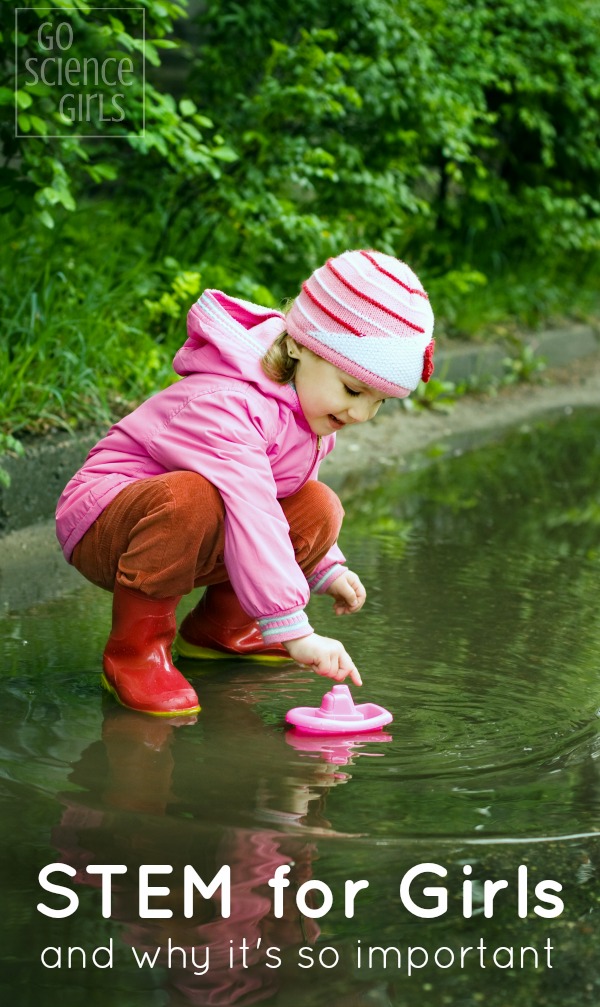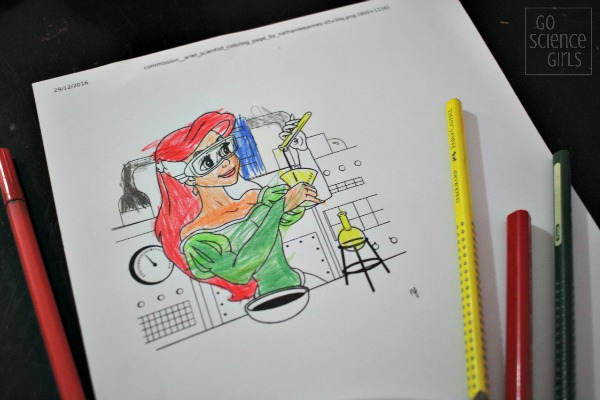As a mother of two little girls who are showing a love science and maths respectively, it’s no wonder that I’m interested in this whole ‘STEM for girls’ movement.
But maybe you’re wondering, “Huh? STEM for girls? What’s that all about?”

Let me answer that question in three parts….
Firstly, what is STEM?
STEM stands for Science, Technology, Engineering and Math (or maths as we call it here in Australia). It’s an acronym that was coined to address the current and future shortage of skilled workers in high-tech fields, and the inadequate education of students in these areas. It’s believed that, by teaching these subjects together, in an inter-disciplinary cohesive approach, STEM education will be more relevant and fun (and thus attract more students), and will develop the sort of critical thinking skills needed in the high-tech workforce, both now and in the future.
What about women in STEM?
The shortage of skilled workers and students in STEM is only half of the story. More alarming is the shortage of female skilled workers and students in STEM. Stats vary by country and by discipline, but generally speaking, women make up only 15-25% of the current STEM workforce, and the gap is broadening.
Why does this matter?
- Well, firstly there’s no evidence that girls are less capable in these fields, but rather that they often ‘feel’ less capable, partly due to stereotyping.
- Then there’s the tendency for STEM jobs to be higher paid, meaning that the lack of women in these roles is contributing to gender salary gap.
- A lack of women in these fields means fewer female role models, both for current female STEM employees, and for girls still forming career choices.
- And what about the whole growth of STEM jobs in the future thing, which is expected to skyrocket…
There’s a lot of work going on behind the scenes by policy makers and educators to remove barriers and encourage women to work and study in STEM fields – which is awesome, but I think it needs to start earlier than that. Much earlier than that.

Why is STEM for young girls important?
OK, let’s just start with STEM for young kids first.
Did you know that research has shown that science achievement gaps emerge by kindergarten (!), and these gaps continue until at least the end of eighth grade? (It says so in this study.)
So, if kids don’t get enough exposure to science concepts and informal learning opportunities in preschool or earlier, then they’ll be starting kindergarten with relatively less knowledge about the physical and natural sciences. And this gap will likely haunt them for the next nine years or more.
Now if we look at STEM for young girls in particular, what’s alarming is that even where there is no difference in STEM ability, a large divide in ‘perceived competence’ for girls can start as early as age five. (This article on the way society treats boys and girls differently, and how boys and girls view themselves even when STEM abilities are equal, is very interesting.)

If you add in the lack of female role-models in the STEM workforce (both in real life, and in the media), the distressing stereotyping and dumbing-down of many ‘girl’ toys, and the often subtle (and not so subtle) marketing of STEM concepts to boys…
See where I’m going with this?
I concur with Tom MacInnes when he says “I am loathe to allow gender distinctions to limit intellectual and personal freedom. I want my daughters to grow up knowing that they have the right to chart their own course when it comes to pursuing their interests and dreams.”
I’m not trying to dictate which career direction my daughters end up taking. I want them to follow their dreams. But I’ll be damned if I let a lack of exposure and stereotypes when they are as young as five years old, cut off a whole cool, highly-skilled, highly-paid, high-growth sector industry, just because they are girls.

How to encourage girls in STEM
OK, so hopefully I’ve got you a little ramped up about the importance of encouraging girls in STEM from a young age.
You might be wondering – how exactly do I do that?
It will differ for each child and each situation. I can only answer from my own personal experiences. Here are some of my suggestions, based on what we’ve tried in our home.
Surround your kids with positive female role-models
The old adage is that you can’t become what you can’t see. Take your kids to female doctors and dentists. Find out if any of the mums at school work in STEM, and then point this out to your child. Seek out books and movies that feature strong female STEM characters. If you’re a mum or female teacher reading this, don’t forget that you can be a positive female role-model too. Next time you need to drill a hole in the wall, do it yourself, and let the kids catch you doing it.
Help them find the answers to their questions
Science is all around us, and preschoolers are great at asking science questions. Sometimes they can ask doozies! Try (your hardest) not to dismiss their questions, and instead help them to find the answers.
Note: I didn’t say that you need to know the answer yourself, or that you need to provide the answer even if you do know it! It’s much more meaningful if you can help them to find the answer for themselves.
You could of course Google the answers, but more meaningful (and empowering) is to ask a librarian to help you find information in a book, go on a field trip, ask a mentor, or my favourite, do a few experiments at home.
Watch your words
Research shows that people tend to speak more often in terms of numbers, quantities and science attributes to boys than girls, from as young as babies and toddlers. So make a conscious effort not to dumb down your conversations with your daughters. Speak less of what girls look like, and speak more of what they are interested in.
Go on lots of science excursions
Visit zoos, museums, aquariums, caves, or whatever other awesome facilities you have near your place, and visit regularly! I find that returning to these sorts of places is more beneficial than just going once. The first visit the kids are overwhelmed and treat the event a bit like going to an amusement park. With the second, third, fourth and fifth visit however, they get a chance to focus in on the aspects that really interest them. They start to improve their vocabulary, ask deeper questions, get a chance to interact with the staff members, and (hopefully) develop a deeper fascination with one particular aspect.
Follow their interests
Kids can often become ultra-fascinated with a particular topic, and that’s really cool! Encourage them to go down that proverbial rabbit hole, and learn as much as they want to about the subject. Borrow books, consult subject matter experts, do fun activities at home. It doesn’t really matter what the actual topic is, it’s more about encouraging their desire to learn, and learn deep! (But at the same time, if kids decide they aren’t interested anymore, let them move on to the next topic. That’s cool too. Let their interests be the guide.)
Fill a bookshelf with awesome non-fiction books
Include age-appropriate reference books on whatever topics they are fascinated with, as well as topics they may not have discovered yet. It’s handy to have these books available for whenever their interest is piqued. Include books on animals and their habitats, volcanoes, astronomy, architecture, and then let kids ‘discover’ these books when the time is right. Science activities and engineering challenges that kids can do at home are also awesome – you can direct kids to these books whenever they claim they are bored.
Provide lots of open-ended toys, including construction materials
Speaking of which, there are lots of fancy toys out there, but I especially like toys that don’t come with a set of instructions. I’m talking about wooden blocks, Magnatiles, Duplo and old-fashioned Lego. I also love ‘non-toy’ construction materials like cardboard boxes, pieces of cardboard, coloured paper, toilet paper rolls, tape, Blu-tac, play dough, straws, craft sticks, chopsticks, pipe cleaners, rope, wool, (large) magnets, scissors, markers. Kids can construct whatever they want – my girls love to use their Magnatiles to build elaborate palaces for their fairies – and in the meantime learn science, engineering and maths principles through play.
Provide ‘some’ construction and science kits
It’s also handy for kids to learn how to follow instructions and build something really cool. That’s where kits come in handy. My only caveat is that this should be in addition to, instead of a replacement of, more open-ended construction play.
There are a few really awesome kits out there that are gender-neutral, or marketed towards girls, and I’m a big fan of these companies! Unfortunately (and frustratingly) many of the cool kits are still heavily marketed towards boys – but don’t let this persuade you. At first, if your kids are sensitive to the marketing, you could rebox the kits into a plain cardboard box. After a while, as their confidence grows, you can start to present the kits in their original packaging, and talk about why companies might package toys in this way, and the effects this has on society etc. You might even fire up a new advocate for the gender-neutral marketing of toys movement!
Provide lots of free time to play. And then don’t entertain them!
This first part is hard! It’s so tempting to fill up their time with dance classes, swimming practice, play dates, excursions, but adding lots of free-time to play is just as (if not more) important. The second part is even harder – try not to fill this free-play time with screens! Yes, the kids will bug you for ‘something to do’. But just explain that it’s not your job to come up with an idea, that’s their job. And then direct them to the bookshelf, the open-ended construction materials, the kits, and the backyard… BUT, be prepared to let them explore, let them make a mess, let them use toys in non-conventional ways, and let them make mistakes.
Come up with cool ways to integrate STEM concepts into how they already like to play
Is your daughter obsessed with Elsa? Create a frozen small world that glows (!) using tonic ice and a black light. Does she have a sweet tooth? Make some homemade sherbet that causes a fizzy chemical reaction on their tongue. (Stuck for ideas – our site is full of fun activities like this!)
Follow the Scientific Method and view failures as discoveries
In science, finding out that something doesn’t work is just as important as finding out that something does. Persist. Tweak your hypothesis, adjust your experiment, and see if you can come up with a way to make it work.
Encourage a growth mind-set
We’re firm believers in our house that if you say you can’t do something, then you’re missing the word ‘yet’. If you want to be good at something, then you need to practice. At first practicing can be hard and frustrating, but if you keep trying, then you can develop the skills to be able to do it more easily, which in turn makes practice more fun. Praise effort over results, because yes, they may need to do some hard yards first.
Use big words in context
Kids are masters of decoding. If you regularly use big words correctly and in context, they’ll quickly work out what they mean and they’ll become part of their everyday vocabulary. If prechoolers can pronounce ‘Tyrannosaurus Rex’ then they can certainly pronounce ‘dehydrated’, ‘asteroid’ and ‘nocturnal’.
Buy STEM Supplies for your home
This is my last suggestion on purpose, as I don’t want to scare you off with a big list of things to buy. There are many science projects you can try, using just everyday household items, so you don’t need buy a bunch of stuff if you don’t want to. But there are some tools that come in handy like a ruler, measuring tape, stop watch, magnifying glass, safety goggles, pipettes, a black light, plastic test tubes.
When the kids are a little older, you might like to invest in some bigger ticket items, like a microscope. (These make great present suggestions for the grandparents too!)

I have a 6.5 year old daughter who loves biology, engineering and fairies and wants to grow up to be a farmer and a vet. I have a 4 year old daughter who is showing an affinity for entomology, maths and gymnastics and wants to grow up to be a doctor (at the moment). I don’t really mind if they end up pursuing STEM careers or not – they can follow their own dreams, however they shape up to be. But I will make sure they know that STEM fields are an option that’s available – for any gender.
More reading on STEM for girls:
- Science, Technology, Engineering, and Mathematics – Wikipedia
- State of Girls and Women in STEM – National Girls Collaborative Project
- Bridging the Gender Gap: Encouraging Girls in STEM Begins At Home – Huffington Post
- Science Achievement Gaps Begin Very Early, Persist, And Are Largely Explained By Modifiable Factors – Educational Researcher
- Why girls need STEM and why STEM needs girls – Today’s Parent
- Why is STEM for girls important? – Mama Smiles
- You might also like to follow our STEM for Girls board on Pinterest.

This post is part of a cool new series called STEM Resources: an A-Z Guide of Understanding STEM & STEAM, hosted by my friend Sarah from Little Bins for Little Hands. Every day this January there will be new posts to help you learn about STEM, and be inspired with some fun STEM & STEAM activities. (Keep an eye out for a few activities from us too!)
And may I also just say a big thank you if you’ve read all the way down to here – this has been a long post! As a bonus, here’s a cool picture of Ariel as a Scientist that the kids to colour in.
You might also like to subscribe to our newsletter to receive all our latest posts directly via email. You’ll also receive some really cool science jokes as our way to say thanks, and welcome! Hope you see you over there!



#
#
Hello. I came across your website whilst looking for a link to an experiment for my friend.
I love it! I’m a Science teacher (and a girl), so I’m excited and happy when I come across websites like yours.
I agree with everything you’ve written in this post. These things and a few extra bonuses (e.g. having “science groups” in primary school where we cooked, dismantled vacuum cleaners and similar “life science” activities) are the reasons why I’m the Science teacher I am today.
You would be pleased to know that next school year I’ll be part of an all-female Science faculty (there’s only 3 of us though lol), and we do STEM classes in addition to Science classes.
I made borax snowflakes with my year 7 students for Christmas (they were free to choose the shape they wanted to make), and we failed at making epsom salt crystal geodes XD Pro tip: if you use plastic shot glasses to replace the empty egg shell you don’t want to deal with, maybe still use the glue to coat the inside with crystals. They took FOREVER to dry!
#
Oh, I loved reading this comment so much!
Your life science activities are awesome – what a great way to make science fun and meaningful. We do loads of kitchen science – I find having something yummy to eat at the end is a great incentive! And dismantling machines is always awesome (or maybe I’m just strange like that, lol.)
I’m so excited to think about all the kids in your classrooms having such great female role-models, normalising that STEM is for both girls and boys.
If you glance over my site, you’ll see that we’ve been slightly borax crystal obsessed lately. They’re so easy to customise for every holiday! Ha! We haven’t tried the epsom salt crystals yet (although I have a box on the shelf just waiting), so thanks for the tip! xx
#
Hi Danya,
I found this article very educative and rewarding. I am the convener of a conference “Raising Girls’ Ambition” in Nigeria. This year our theme is ” Equipping Girls for Involvement in STEM for Sustainable Development. The conference is in October, who knows if you get a travel grant, you could be our guest speaker at the conference. Lets keep this line open. Peju Oti
@pejuoti
#
Hi Peju Oti – what a great conference you’re planning, I love it! And as for guest speaker – wouldn’t that be amazing!
#
STEM for girls needs a counterpart !
CRANE for boys: non-violent Conflict resolution; Relationship; Attachment; Nurturing; Empathy & Emotion
If you agree, Please Pass This On!
thanks
#
Ooh I love this idea!
#
STEM for girls isn’t about changing their gender roles or ideas, it’s allowing them to think/partake in jobs and interests that are/have been traditionally male careers. We aren’ttrying to make them more masculine, so why the CRANE for boys, to try to reduce their gender roles or feminize their thinking? Really? Let boys be boys, let girls be girls, bot open the options. My 14 year old daughter can shoot a rifle and a bow, she has soldered, mig welded, sand blasted objects, cut metal and wood with power tools, and used an airbrush. She has helped repair sprinklers, perform a brake job on my truck, and has been taught the basics of electricity. She also fosters kittens, bakes and cooks, and loves interior design. I am not trying to influence or change her, just trying to expose her to as many things as possible to make her more capable and able to decide what she would like to do with more options available. Boys are allowed to perform any job they want these days, so should girls be. I love capable women, but we don’t need to try and CHANGE their thought processes, or those of boys (teach them nurturing and empathy classes, etc). At the end of the day, boys gravitate towards boy things, girls gravitate towards girl things. We should be exposing them to many things that are less gender based and opening them to different career options, but not trying to feminize boys or masculinize women. I feel theat men are attempting to be feminized too much already. Males and females are supposed to be different.
My thoughts.
#
Thank you for sharing about the importance of encouraging girls in STEM. Are you familiar with KEVA Planks? They are a wonderful tool for encouraging creativity and STEM thinking. Kevaplanks.com
#
Youre a sexist feminist stop spreading your propiganda all men have mothers and most have sisters and daughters youre making women out to be heavy influential dumb and non-creative for their self. women’s equality is definitely a thing in our time all jobs for men are definitely open to women and I see most women fulfilling those jobs and excelling in them.im a man and a firm believer in womens rights and equality and you trying to hold them downi have a wife a mom and 6 sisters andd a beautiful smart daughter so stop downing on men pig.. i could go on but ill stop there
#
#
Hello Danya,
Nice to hook up with you again. I am Adepeju Oti, Convener Raising Girls’ Ambition International Conference. We are based in Ibadan, Oyo State, Nigeria. I message you about 2 years ago on the possibility of you being a guest speaker. Well know one knows the outcomes of this Coronavirus pandemics. But all thing being equal, the conference holds on October 13-16, 2020. It is an annual conference, you could still consider being a guest speaker. And if you are skilled and certified in Coding and programming; there are other opportunities of collaboration.
Please let’s keep this conversation open. You can reach me via my email. Thank you
#
Hi Adepeju,
Thank you so much for your kind message. I would absolutely love to visit you in Nigeria! Unfortunately an overseas trip like that won’t be possible this year, but perhaps another year?